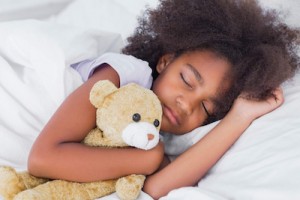Parasomnias: When Sleep is Scary
 By Lili Poon, MD, Novant Health
By Lili Poon, MD, Novant Health
Night terrors, confusional arousals, sleepwalking and sleep talking: Most of us have heard of these or experienced them for ourselves. If you’re a parent, it’s likely that you’ve seen your child through one of these episodes. But what are they?
Parasomnias are unwanted or abnormal behaviors that occur during non-REM sleep. Though parasomnias can be concerning for a parent to witness and experience, they are not usually associated with negative health consequences. Often these conditions can be remedied or alleviated by helping your child get more sleep.
What are the most common parasomnias and what should you do, or not do, when your child is experiencing one? Let’s find out:
Sleepwalking
During a sleepwalking episode, the child may appear to be awake, wandering the home either in silence, mumbling, talking or yelling. As confusing as it can be to witness, the child is asleep and unaware they are sleepwalking. Sleepwalking can be dangerous if the right precautions are not taken to ensure a child’s safety, such as securing exterior doors, putting sharp objects out of reach and removing unstable furniture that they could bump into.
Confusional Arousals/Sleep Talking
Confusional arousals are variants of sleepwalking, where the child does not leave their bed. During a confusional arousal, the child may look awake and cry, talk, point or even arrange their stuffed animals on the bed. Sleep talking can range from mumbling, to clear conversations, to yelling out.
Night Terrors
Night terrors, also known as sleep terrors, can be the most disturbing to parents of all of the parasomnias. Unlike nightmares that occur during REM sleep, night terrors happen during non-REM sleep. During a night terror, the child may continue to be laying down or sit up, appearing frightened and scream or cry. Their eyes may be open, but they do not appear to improve with calming interactions of the parent.
Parasomnias can be relatively common. According to the National Sleep Foundation, parasomnias affect approximately 16% of children. They occur in people of all ages but are more common in children and most likely to happen during non-REM sleep, within the first few hours. Interacting with your child in this state may prolong the episode or worse, prompt an irritable, aggressive or even violent response from the child. If they are sleep talking, having a confusional arousal or night terror and have not left their bed, check on them and if they are safe, leave them alone. The more we interact, the longer and more violent the behaviors can get. If they are sleepwalking, try to gently redirect your child back to bed.
Parasomnias can occur when a child is not getting enough sleep for their age. Children require much more sleep than we do as adults, but don’t always get it. Though children ages five and under require 12 hours of sleep per night (in addition to daytime naps), most families set bedtimes permitting only eight to 10 hours of sleep. Many children who suffer from parasomnias see an improvement simply by improving their sleep duration, for their age.
It is a common misconception that children outgrow parasomnias as they get older. The parasomnias improve as their sleep requirement decreases with age to meet the sleep schedule implemented in the home. Parasomnias may recur in adulthood when unforeseen circumstances cause us to be sleep deprived. So remember, enough sleep is crucial to maintaining a good, quality sleep for children and those who care for them!
Dr. Lili Poon is a fellowship trained pediatric sleep physician and the pediatric sleep medical director at Novant Health in Charlotte, NC. Dr. Poon completed her fellowship at Case Medical Center in Cleveland, OH, and did her pediatric sleep training at Rainbow Babies Hospital in Cleveland.
This blog was produced in partnership with Charlotte Parent. Click here for the original post and other parenting resources.













